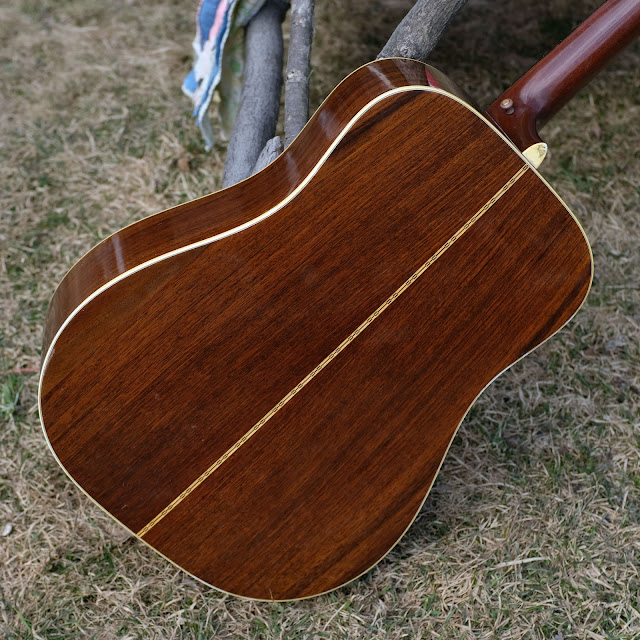1972 Martin D-28 Dreadnought Guitar
A consignor has owned this guitar since '76 and has kept it well, though time does plays its little tricks on older guitars notwithstanding. D-28s are popular guitars because they offer a creamier, fuller voice than the more-usual D-18s and their mahogany back and sides. This gives them an edge for straight chord and back-up work while still offering a solid punch.
Old work on this guitar included a replacement piece of back wood at the lower bout (smaller), a very light bridge shave, a refret, and possibly a neck reset (there's some evidence of it at the fretboard extension). The owner does not remember much of that work so it suggests some it was done before he owned it. There are a few tight hairline cracks (and some chip-out in the fret slots at positions 1-5) in the ebony fretboard that are a non-issue structurally. The pickguard is also a newer, oversize replacement and the endpin is a replacement, too. Other than the back-panel replacement section, though, the body is clean save weather-checking and crack-free.
My own work included reseating of some frets, a fret level/dress, clean-up of the earlier bridge shave work, string ramp additions, and a good setup. The frets posed a bit of a challenge because whoever refretted it both planed the board a little flatter than original, glued the frets as well as hammered them in, and also induced a backbow in positions 1-5 by accident. I had to raise those (and other) frets a hair to get them more-or-less level before my level/dress job, and there's a bit of muck on the board due to some of that work from frets 1-5... though it's not obvious at a glance. The fretboard extension over the body slopes slightly down from the rest of the board and towards the body. The guitar now plays quick and has an effectively straight neck in service.
Specs are: 25 5/16" scale, 1 11/16" nut width, 1 1/2" string spacing at the nut and 2 1/8" at the bridge, 15 5/8" lower bout width, 11 1/2" upper bout width, and 5" depth at the endblock. Action is spot-on at 3/32" EA and 1/16" DGBE at the 12th fret. Heavy-handed players might want to shim the saddle with 1/64" or 1/32" material, though. The board has only the slightest radius to it and the neck has a mild-to-medium, soft C/V hybrid shape.
The saddle has 1/16" spare height for adjustments. The bass side wing of the bridge has a 1mm separation on its very back edge that is absolutely no worry.
The old Grovers are doing just fine.
Here's the presumably-replaced section on the back, lower-bout. The job is good and it's not obvious at first and has cleating along its length.
An original (or at least period) hard case comes with the guitar and it's in good shape except for a replaced, funky leather handle. I'd wrap it in black duct tape with some foam padding and it'd be good to go.

















Comments